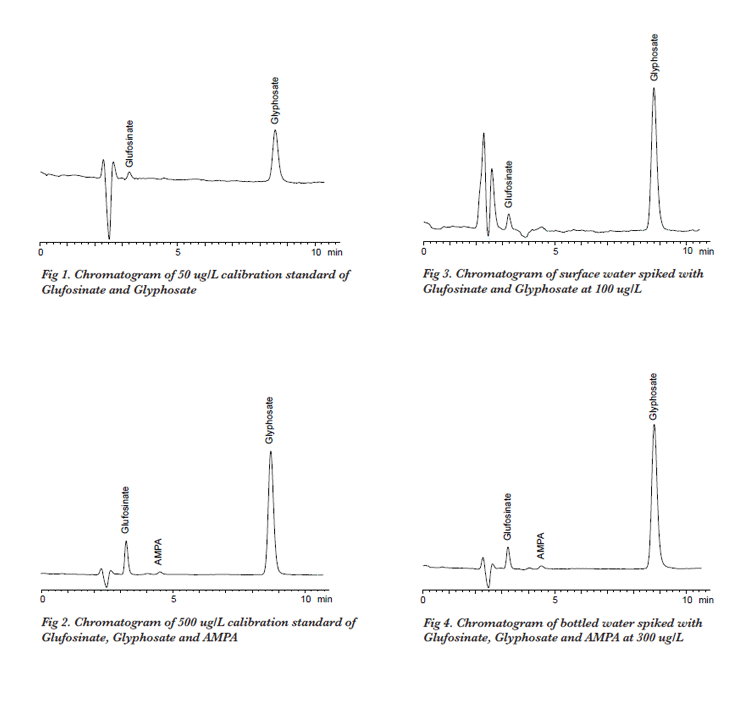MA 296 / ANALYSIS OF GLUFOSINATE AND GLYPHOSATE IN WATER BY HPLC WITH POST-COLUMN DERIVATIZATION
Glyphosate is a broad-spectrum herbicide that has been used for several decades to protect a variety of crops. Due to its heavy use in agriculture many weeds have developed resistance to Glyphosate causing increased interest in finding alternative herbicides. Glufosinate also provides broad-spectrum weed control and can be successfully used against many Glyphosate-resistant plants and grasses. Glufosinate has become increasingly popular creating need for analytical methods to monitor food and water to ensure protection of human health and environment.
EPA mandates maximum contamination level (MCL) for Glyphosate in water at 700 ug/L. EPA Method 547 describes Glyphosate analysis in drinking water by direct-injection HPLC with post-column derivatization. Glufosinate contains a primary amino group and is also capable of reacting with o-Phthalaldehyde (OPA) reagent. Utilizing mixed-mode analytical column allowed us to develop a simple method capable of separating Glufosinate and Glyphosate in water with direct injection. This method eliminates complicated and labor-intensive sample pretreatment steps, required by LC/MS analysis. Postcolumn derivatization with OPA reagent ensures high sensitivity of analysis without matrix interferences or signal suppression.
METHOD
Calibration:
Calibration range for Glyphosate and Glufosinate is from 25 ug/L to 1000 ug/L. A quadratic calibration curve with R2=0.9998 is observed for Glufosinate. A linear calibration curve with R2=0.9998 is observed for Glyphosate.
Sample Preparation:
ilter water samples though 0.45 um Nylon filter, inject
Analytical Conditions:
Column: Acclaim Mixed-Mode WAX-1, 4.6×150 mm (Thermo Scentific)
Post-column Conditions
Post-column System:
Pinnacle PCX or Vector PCX
Heated Reactor Volume: 0.5 mL
Temperature: 36 ºC
Ambient Reactor: 0.1 mL
Reagent 1: 90 uL of 5% NaOCl (Bleach) in 950 mL of GA116 Diluent
Reagent 2: 100 mg of OPA and 2 g of Thiofluor in 950 mL of GA104 Diluent
Reagent Flow Rate: 0.3 mL/min each reagent
Detection: λEX 330 nm, λEM 465 nm
Column Temperature: 55 ºC
Flow Rate: 1.0 mL/min
Mobile Phase: 85% of K600, 15% of ACN2
Injection Volume: 100 uL
Analyte
Surface Water
Glufosinate
Spike
RSD, N=3
Recoveries
Spike
RSD, N=3
Conclusion
This simple, fast and sensitive method allows simultaneous detection of Glufosinate and Glyphosate in drinking and surface waters. The method utilizes common HPLC equipment and doesn’t require complex extraction and derivatization of the samples prior to injection. Avoiding sample pretreatment steps reduces analysis time and costs as well as minimizes errors. This promising protocol can be easily adopted by laboratories, especially the ones already set up to run Glyphosate analysis according to EPA Method 547.
Pickering Laboratories also plans to expand this protocol to including analysis of Glyphosate and Glufosinate in vegetable samples.
Bottled Water
Glyphosate
Glufosinate
Glyphosate
100 ug/L
100 ug/L
100 ug/L
100 ug/L
3.7%
1.0%
4.2%
0.8%
96%
94%
85%
92%
300 ug/L
300 ug/L
300 ug/L
300 ug/L
2.5%
0.6%
2.1%
0.5%
Recoveries
87%
93%
87%
92%


